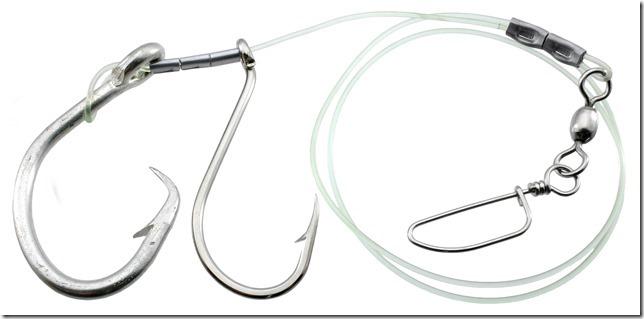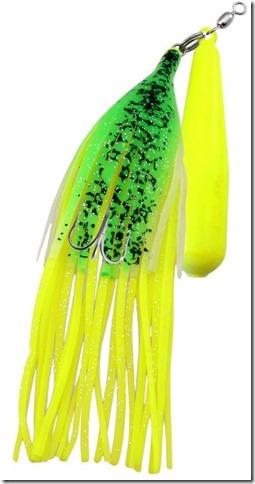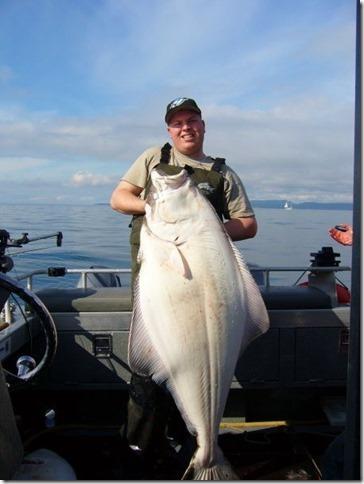In the last two decades halibut angling has really taken off in British Columbia. The popularity of these highly prized fish has been increasing on a yearly basis and in some areas of the coast halibut actually challenge chinook salmon as the most sought after game fish. Halibut have always been a popular sport fish in Alaska and in northern BC waters where the resort operators were early to recognize their customer appeal. However in southern BC most weekend warriors were much slower to jump on the halibut bandwagon, but once they did the switch was dramatic. In the 1970s and 1980s when I began fishing Barkley and Nootka Sounds in August and September it was extremely rare to see any halibut brought into the campgrounds, now they are a staple for every lodge and charter operator on the west coast of Vancouver Island.
Advertisement

The history of European commercial halibut fishing on the West Coast goes back to 1888, when East Coast halibut fishermen arrived in BC. The recorded history of European contact with Pacific halibut goes even further back. In 1778, during Captain Cook’s third voyage, his crew apparently landed one hundred halibut in one hour near Shumagin Island in Alaska’s Aleutian chain. While the accuracy of the catch might be suspect, it is clear that halibut were abundant and that Europeans were familiar with this species at a very early stage of exploration. They were also aware of its value to native tribes along the coast. In fact halibut continue to be a main source of food for coastal tribes, second in importance only to salmon. It has been estimated, based on some catch data collected in 1885 from Washington tribes, that coast-wide the tribes harvested three million pounds of halibut a year. That’s a lot of halibut considering that recent Canadian Total Allowable Catches (TAC) of halibut have been around seven million pounds. Native fishermen also developed sophisticated fishing gear and tactics. In fact when the east coast commercial fishermen arrived it was said that the tribal fishermen always out-fished them with traditional methods.
By the early 1890s a small boat halibut fishery, often using converted sealing vessels, started up in southern BC and Washington State. It appears that halibut stocks inside the main body of Georgia Strait were never large enough to support an economically viable fishery, as records show the bulk of the catch came from southern Georgia and eastern Juan de Fuca Straits including the US side and Puget Sound. Not surprisingly, these were the first areas to suffer from overfishing. The increase in fishing effort was partly fueled by new market demands from the east made possible by shipping fish across the continent by railroad. Over the nextfew decadesthere was significant expansion of the halibut fishing effort from inside to outside waters north towards Alaska and along the west coast of Vancouver Island. The fishing effort was intensified through technological advances in fishing gear and by the capacity of vessels to travel further afield. According to W.F. Thompson, a well-respected US fisheries scientist and biologist who later headed the International Pacific Halibut Commission (IPHC), halibut stocks were being severely over-fished as early as the beginning of the 20th century. By this time prime BC halibut grounds had already been depleted at a rate of 75% per decade. He noted this conservation concern in a 1930 report to the International Fisheries Commission called The History of the Pacific Halibut Fishery. In this document Thompson states that fishing’s “mechanical advantage [meaning advancements in fishing technology] is recklessly reaching into the age old treasures of nature for food”.
Advertisement
Since the 1930s the IPHC has done a good job of looking after Pacific halibut stocks. The Commission is a bi-lateral body that sets the TAC for halibut fisheries in Canadian and US waters. When the catch limits for each country have been set, the management of halibut fisheries falls to the appropriate national regulating agencies. In Canada it is the Department of Fisheries and Oceans (DFO). The Canadian TAC, after native and science requirements have been deducted, is split 85% and 15% between commercial and sport fisheries and is expressed in total pounds of fish. Sport fishing regulations are then determined through negotiations between DFO and the Sport Fishing Advisory Board. For the 2015 season these rules are set at one halibut per day, two halibut in possession, one of which may be over 90 cm, maximum size is 133 cm, a six fish annual possession with a February 1st season opening and the closure date linked to hitting the allotted poundage. There are some variations for Area 121, so anglers should consult the DFO website for details that are different than the general coast-wide regulations noted above.
Halibut Tactics
Many charter skippers and keen halibut anglers use a high-tech but effective anchoring system. It allows the boat to lay off the anchor float about fifty feet, as opposed to dropping the anchor off the bow of the boat. The anchoring tackle includes enough anchor line to provide sufficient scope based on the greatest depth the angler plans on fishing over. The anchor line runs through a pulley/ring system which is attached by a short lead to the float known as a Scotchman. The system also includes an extra ring set ahead of the float which acts as a stopper to prevent potentially loosing the anchor line and tackle. It also stops the float from getting too close to the boat due to changes in current or wind direction. Skippers run a separate line from the bow to the stern cleat and attach the main anchor line to this rope using a metal snap. This lets the line run to the bow while anchored, but allows for a fast release for safety reasons or to get away from the anchoring tackle while playing the fish. You can anchor in the traditional fashion, but it has obvious disadvantages; not the least of which is retrieving hundreds of feet of ground tackle manually. Or worse, losing all of your gear if you have to release the anchor for safety reasons or if it’s hung up on the bottom and you don’t have the manpower to get it free. Check the web and you will find a number of videos that show how to set up this system.
Advertisement
Drifting is another successful means of catching fish. We used this technique many decades ago when I fished with Earl McDormand, a Victoria halibut fishing legend. Earl, along with a handful of other halibut pioneers, started fishing the flats around Race Rocks almost forty years ago. This was my first ever halibut trip. We arrived at Race Rocks before slack water and after shutting down his main engine Earl set his trolling motor speed to dead slow. He then handed me a stiff Peetz rod/Peetz reel set-up loaded with Dacron line and a weighted spreader bar baited with whole herring. The technique was simple. Lower the spreader bar until the suspended weight hit bottom, reel up a couple of turns and set the rod in the holder then wait. If the weight rubbed on the bottom, signaled by the rod tip erratically jerking upward, pull it up a turn or two and keep watching. When a halibut took the bait the rod tip bent slightly towards the water followed a few seconds later by some harder downward pulls. The system worked for us that day as we landed a nice “flattie” in the thirty pound range. Fast forward over thirty years and the tactic still produces fish although the gear choices has improved to include properly designed six-to seven-foot halibut rods with stiff butt sections and limber tips. These rods are matched with fast retrieve star drag reels loaded with thinner, stronger non-stretch and abrasion resistant line.
Slow trolling with downriggers is a less used halibut tactic but it can be extremely effective over fishing ground that is a mixture of sand, gravel and small cobble. Simply rig a large whole herring in a Herring Teaser with tandem single hooks, or a very large hoochie tipped with some type of real bait, and attach them to your downrigger cables. It’s the same process used to attach a salmon lure to a downrigger but with a shorter drop back. Lower the cannonballs as close to bottom as possible, even let them bump bottom if the ground allows for it. You can use standard halibut rods but you’ll have a lot more fun if you rig them on your heaviest salmon rods. The vast majority of halibut that anglers are going to hook up with are from 10 to 40 pounds or exactly the same size as mature salmon. Stout halibut tackle is mainly used so anglers can effectively fish heavy lures at greater depths and not so much to subdue the fish once they are hooked, although it would be unwise to try to use heavy jigs or spreader bars with conventional salmon rods and small single action reels.

Lures
Natural Baits
Medium to large sizes of frozen or fresh whole herring rigged on a spreader bar or trolled slowly is a good presentation for halibut. Many anglers swear by squid or octopus rigged the same way, while other anglers claim that salmon bellies are dynamite bait presentations. The fact is that halibut will go for a range of real bait including anchovies and pilchards. Mooching or cut plugging with herring is also an effective technique. Try to use the freshest bait possible and avoid baits that have severe freezer burn. Halibut, while considered bottom feeders, are very predatory and as such are accustomed to eating live prey. Use tandem single hooks or circle hooks whenever possible and try dressing up your natural bait by adding a brightly coloured Teaser head when trolling herring. Other enhancements include using tandem hooks tied with coloured Dacron line or with pink, glow or red plastic tubing slid over the line to add some pop to the presentation. Other examples include adding a few glow beads or even a large white hoochie positioned on the line right in front your natural bait.
Metal Jigs
Fishing with large heavy metal jigs has become one of the common techniques for halibut angling in BC. Of the multitude of jigs that anglers can use, the pipe jig with a hoochie attached to its top end is probably the number one choice. The base colours for the metal part of these jigs are usually shades of glow, white and bright chrome and may include a secondary colour like pink, red or chartreuse. The tactic is to lift the jig about a foot to a foot and a half off the bottom, then drop the jig until it hits bottom. The lift and drop causes the hoochie to flutter and the thump when it hits the bottom creates a disturbance designed to catch the halibut’s attention. Large traditional-shaped cod jigs can also be effective, as are smaller salmon or rockfish jigs when fishing in shallower water.
Soft Baits
Soft baits include swimmer tail jigs. This jig style is a combination of a lead weight with a soft plastic lure attached to it. A large single hook embedded in the lead is fixed in the upward facing position to avoid snagging on grabby bottom structure. They are more commonly used for rockfish but can also be effective on halibut. These swim baits work best using the same jigging tactics described above either from an anchored position or from a drifting boat. Drifting allows the jig to bounce along the bottom which improves the action of the flexible plastic tail. They come in a variety of sizes, shapes and colours but I would recommend using heavier weighted models with longer more active plastic tails. Hoochies also fall into the soft bait category and will take halibut if trolled very slowly with a flasher or dodger that barely activates the hoochie. White, glow or productive salmon hoochie colours also work for halibut. Bigger plastic baits are always a good choice and they should be slowly trolled with downriggers set close to the bottom.

Proven Vancouver Island Halibut Locations
Vancouver Island is blessed with some excellent halibut fishing areas. Prime halibut grounds start in the southern Gulf Islands and run all the way up the west coast of Vancouver Island to Cape Scott, then down the inside waters past Port Hardy to Sayward. The main body of Georgia Strait has never been considered prime halibut ground, however that might be changing. Rumours of better halibut fishing in Georgia Strait were confirmed in a recent email from Courtenay resident Ralph Shaw. Ralph is a die-hard fisherman and he suggested that more halibut were being caught in northern Georgia Strait than previously. While he was not able to confirm how many anglers were targeting halibut he did say that the incidental catches by anglers trolling for salmon was definitely on the rise. He believes these fish are coming through Johnstone Strait. They are generally smaller, in the ten to thirty pound range and are being caught at the hump south of Campbell River, Century Shoals, the hump off Kitty Coleman, Cape Lazo and Grant’s Reef. When he does try for halibut he fishes areas with a sandy bottom, trolling deep with either a large spoon, or a green hoochie on a fifty inch leader behind a gold Betsy flasher. This set up gives him a chance to hook up with either halibut or salmon. This shows that halibut can be caught anywhere, including waters with little history of producing fish. However there are locations that do have a long history as halibut hotspots, some of which are easily accessible for single day fishing trips.
Victoria/ Eastern Juan de Fuca Strait
This area is one of the most accessible regions of the coast to fish for halibut and salmon. It is a major resident and tourist fishing destination where prime fishing grounds are within twenty minutes of launching sites and marinas. Oak Bay, Pedder Bay and Cheanuh Marinas are the primary access points while the Esquimalt Anglers Association ramp has ample capacity for trailer boat traffic. Martin Paish from the Oak Bay Marine Group knows these waters and has this advice for catching south Island halibut: He notes that this early season fishery is highly under-rated, but does require some technical understanding of anchoring in areas with strong currents and 200-foot plus fishing depths. Consequently it is best to fish currents less than two knots or, if anglers are unfamiliar with the area, to hire a guide for their first trip. Because of the currents there are up to fifteen fishable days per month of which less than half a dozen are considered excellent. This means consulting the current tables, identifying the days with slow moving currents and building your fishing plans around this critical information. Slack tides are not as productive as one might think as these halibut like some water movement which brings feed onto the banks and shoals. The best known fishing areas include Constance Bank, Albert Head, the banks and shoals around Race Rocks outside the marine protected area, as well as banks further offshore that straddle the Canada-US border. Good fishing starts in February and builds through April and May when the action shifts to salmon, but halibut can be caught right into the fall months. Anchoring is the best technique as it out-fishes drifting by a factor of at least five to one, so the tactics and heavy tackle previously described for anchoring with spreader bars and real baits work best in these waters. Anglers prefer whole herring, mackerel, squid, salmon bellies, octopus and salmon heads fished on circle hooks which improve the survival of released fish. When the dogfish are around, Martin switches his lures to curly tailed jigs or big spoons. Finally, anglers need to be very weather wise as the afternoon wind can come from the west with a vengeance between May and late August. The area is also prone to thick fog, which flushes in and out at the mercy of the wind direction.
Port Hardy/ Queen Charlotte Strait
Port Hardy lies right in the middle of prime halibut ground that runs from Cape Scott all the way through the inside waters to Sayward. This is principally a tourist fishing region with charter operations, some fishing resorts and tourist accommodations as well as boat ramps and tackle shops for those who bring their own boats. The weather can be an issue but it is generally calm during the peak fishing months of June until October. Jim Henschke and his wife Nita own the Bait Shack and Castle Point Charters and have a wealth of knowledge about the area’s salmon, bottom fish and halibut fishing tactics. The Bait Shack is located at the Bear Cove Marina and they only carry tackle and bait that anglers need for fishing this area. Here’s Jim’s analysis and advice for halibut fishing out of Port Hardy: These halibut are migratory with the smaller fish showing up first, followed by large fish in the summer with the barn doors coming in September and staying around until November. It is generally a deep water fishery, anywhere from 250 to 350 feet, and the bites can come on throughout the day. Unlike the small tide and current fishery recommended for Victoria, Jim suggests fishing the bigger tides in order to get long drifts over productive water. He also suggests fishing the lee sides of the banks and shoals which allows anglers to fish ebb or flood tides at the same location. Because it is a deep-water fishery, this is mainly a big jig heavy tackle show. His jigs are usually tipped with high quality mackerel, herring, octopus and salmon bellies. Jim is also a big fan of using extremely sharp circle hooks or J hooks on 80-150 lb test leaders when fishing bait on spreader bars. Top locations near Port Hardy are the Airport drift, Taylor Bank, Chrissy Pass and Ripple Passage. Taylor Bank and the Airport drift can be fished on both tides, but the flood is usually better at Taylor Bank. Fish the bumps at Chrissy Pass on the flood and fish Ripple Passage, which also holds lots of lingcod and yellow eye, on a small tide. Finally you may have to move around a bit to find the fish but that is part of the adventure and enjoyment that comes from fishing this rugged part of the northeast coast of Vancouver Island.
West Coast Vancouver Island /Port Renfrew to Quatsino Sound
The west coast of Vancouver Island is an immense area with countless fishing destinations. Many experts believe that the region’s collective sport fishery is unmatched on the west coast of North America. Between Port Renfrew and Quatsino Sound there are hundreds of qualified guides and scores of resort operations offering their services in true wilderness settings. The terrain ranges from deep, steep sided inlets linked to expansive island studded sounds, to rugged surf-pounded beaches and promontories, to offshore banks featuring ocean swells with the closest land sometimes twenty miles away. Halibut can be caught in nearly all of these areas. In spite of this remoteness nearly every key fishing region is accessible to trailer boat anglers. However these anglers must have the basic skills necessary to fish in challenging conditions. So their boats need to be properly equipped with navigation, communication and general safety equipment. Because the area is so large and the halibut fishery so diverse it’s impossible to detail each destination’s fishery without filling a book. So the best way to explain the region is in general terms. Good numbers of halibut are found inshore at the start of the season and in some locations, like Barkley Sound, can be caught well inside the surf line. Almost every tactic and gear type listed in this article will take fish during the early season inshore fishery. As the season progresses the action moves to the outer banks. These banks begin at Swiftsure at the entrance to Juan de Fuca Strait and are interspersed up the length of the Island. Anglers who are unfamiliar with offshore fishing might first consider taking a guided trip before venturing offshore in their own boats. The outer bank fishery runs through the late spring and summer season and provides mixed catches of salmon and mid-sized halibut. Trolling near the bottom with spoons, hoochies and sometimes bait; or jigging with artificial lures are all productive methods for taking these large flatfish from the offshore waters. Anchoring is also a common tactic if the anchoring ground allows it. Potential visitors to the west coast of the Island should know that the further north they go the more remote the geography becomes. Port Renfrew, Barkley Sound, Bamfield, Ucluelet and Tofino are all accessible by a few hours driving from Victoria on good paved or, in the case of Bamfield, maintained gravel roads. Once north of Clayoqout Sound access is either much more difficult or takes much longer. Anglers planning to fish unfamiliar west coast Vancouver Island destinations need to do some research and then decide whether they want to go on their own, use charter services or purchase resort fishing packages.
